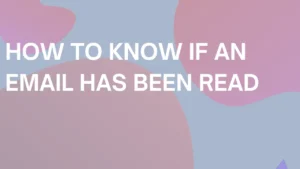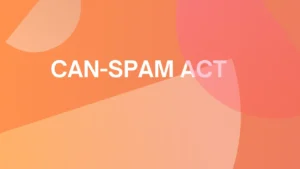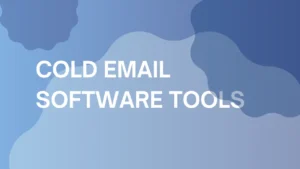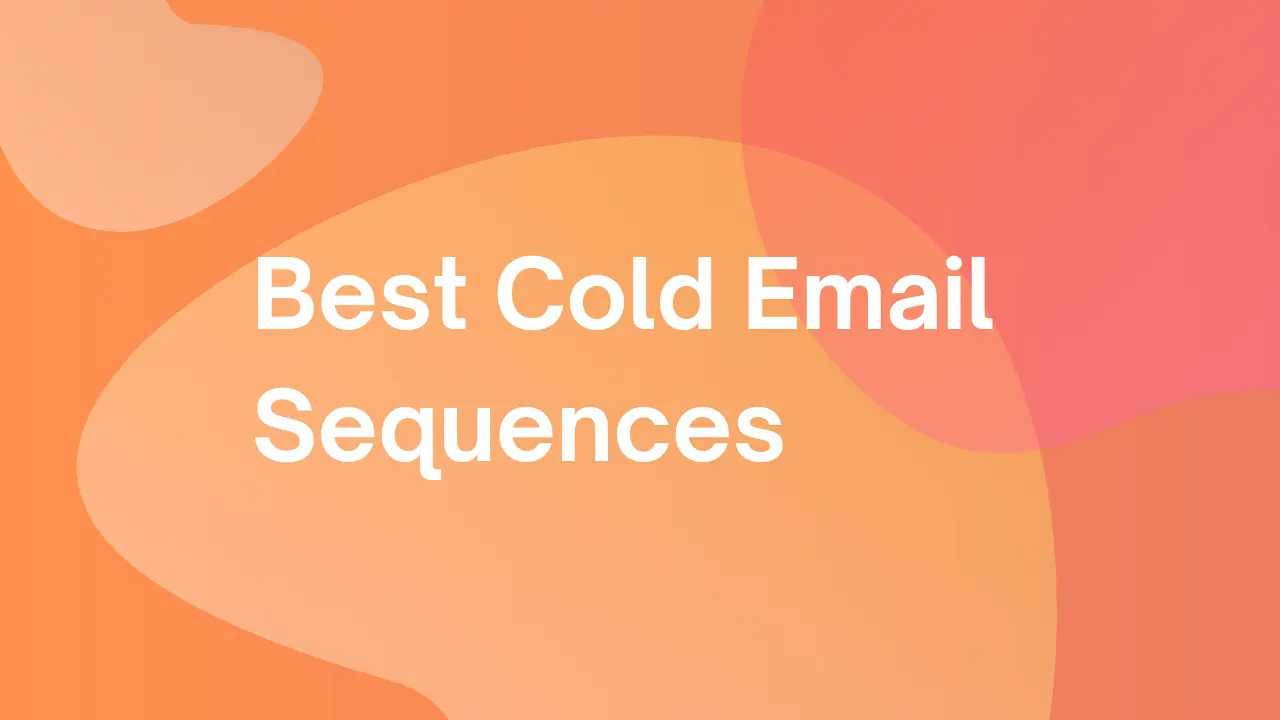
The Best Cold Email Sequences on the Web
Today, we’re breaking down the most effective cold email sequences—what works, what doesn’t, and what’s achievable based on data-driven insights. We bring you actionable steps straight from user communities and industry experts so you can aim for results that are both realistic and impactful.
Here’s the truth about cold email response rates: typically, 1% to 5% is average, and 5% to 8% is considered strong across most industries. Those 30% response claims? Rare, and often only achieved through ultra-niche or highly personalized campaigns.
Based on real-world data and insights from Reddit, here’s what moves the needle in cold email sequences:
- Personalization that matters: Go beyond “Hi [First Name]” and dig into real pain points or industry challenges. Emails that show genuine research and relevance can see response rates go up by up to 142%.
- Timing is everything: The best send times are typically between 8 a.m. and 11 a.m. on Tuesdays and Wednesdays, when inboxes are active but not overloaded.
- Industry-specific response rates: Response rates vary widely—legal services and education can hit 7-10%, while industries like IT or fashion stay closer to 3-4%.
What to do before going for templates
Before jumping into templates, let’s get your email setup dialled in. As suggested by users on Reddit and backed up by our experience, technical prep is absolutely necessary.
Here’s a quick step-by-step guide to help you get your emails “in shape” and ready to go:
- Warm Up Your Email Address
If you’re using a new email address or haven’t been actively sending emails, start with a warmup process. Using a tool like Warmup Inbox helps build a positive sender reputation by gradually increasing your send volume over a few weeks, reducing the risk of your emails ending up in spam.
- Set up SPF, DKIM, and DMARC
SPF, DKIM and DMARC are like your email’s passport, ID, and background check all rolled into one. They show email providers that your messages are legit:
- SPF: This record tells other servers that your email domain has permission to send from your server, cutting down on spoofing.
- DKIM: Adds a “digital signature” to your emails, like a stamp of authenticity, that keeps you out of the spam folder. Both SPF and DKIM require a quick DNS update.
- DMARC: Ties it all together by setting up rules for how servers should handle unauthenticated emails. Adding this keeps your domain reputation clean and signals credibility.
- Clean your email list
A clean list means fewer bounces and better deliverability. With EmailListVerify, you can quickly identify and remove invalid or risky emails, making your campaigns more effective immediately.
- Run deliverability and spam tests
Before sending your sequence, run a technical test to identify potential spam triggers in your subject lines, content, and formatting. Email Spam Words Checker can give you insights into your likelihood of landing in the inbox, helping you refine and improve deliverability.
- A/B test your key components
Experiment with elements like subject lines, timing, and email length to see what resonates best with your audience. A/B testing helps you maximize open and response rates, fine-tuning your approach with each send.
Setting realistic expectations for success rates
While we’ll provide typical success rates for each sequence, remember that results can vary widely based on factors like the type of campaign, the audience, and the product you’re offering. There’s no single formula that guarantees high response rates every time—what works well in one industry or audience might miss the mark in another.
Treat these success rates as a starting point rather than a rule to get the best results. Experiment with different sequences, test your messaging, and adjust based on what you see.
Best cold email sequences (according to us)
The 3-step cold email sequence
The 3-Step Cold Email Sequence is simple but effective for generating responses without overwhelming your prospects. It typically includes an initial email, a follow-up, and a final attempt. Here’s a breakdown of each step, along with template examples to get you started:
Step 1: Initial email
The goal of the initial email is to introduce yourself, establish relevance, and create curiosity. It should be short, personalized, and focused on the recipient’s needs or challenges.
Average Response Rate: According to statistics, initial cold emails generally see response rates between 1% and 5% across most industries, though this can increase with strong personalization and targeting.
Step 2: Follow-up email
The follow-up email is sent if there’s no response to the initial email. Its purpose is to provide additional value or information, gently reminding the recipient of your offer without sounding pushy.
Average Response Rate: Follow-ups often see a slight bump in engagement, with typical response rates around 2% to 7%, especially if they add new information or value.
Step 3: Closing email
The final email in this sequence is a last attempt to get a response. It’s polite and to the point, with a soft “break-up” line to close out the outreach gracefully.
Average Response Rate: Final emails in a sequence typically yield 1% to 3% response rates. The break-up tone can sometimes prompt a reaction from prospects who were on the fence.
This 3-step sequence is effective for keeping prospects engaged without overwhelming them. With some tweaks to personalize and adapt to your audience, it can be a solid foundation for generating interest and responses in your outreach efforts.
The AIDA sequence (Attention, Interest, Desire, Action)
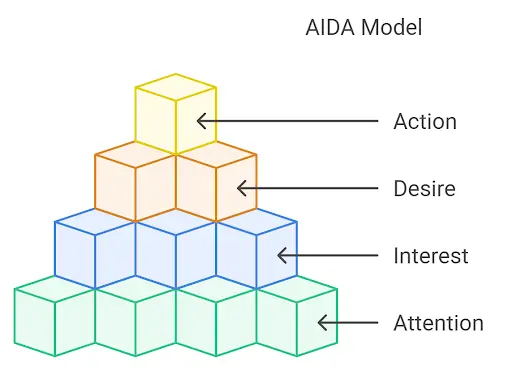
The AIDA model is a classic formula for crafting persuasive emails, breaking down the message into four key steps: grabbing attention, building interest, creating desire, and prompting action. This approach works well in cold emailing because it guides the reader smoothly from curiosity to a clear call-to-action.
Best for: Healthcare and wellness, Education and online learning, Digital marketing agencies
1. Attention-grabbing subject lines
Start with a compelling subject line that sparks curiosity or offers immediate value. A strong subject line is critical to ensuring your email gets opened.
Examples:
- “Boost [Their Company’s Metric]: Here’s How”
- “Quick solution for [specific pain point] at [Their Company]”
- “[First Name], you might find this helpful for [challenge they face]”
2. Building interest in the Body
Once they’ve opened the email, quickly build interest by introducing a relatable pain point or challenge. Show that you understand their needs and are familiar with their industry or role.
3. Creating desire with value propositions
Build desire by clearly explaining the benefits of your product or service. Use specific examples or results to highlight why your solution is unique and valuable.
4. Driving action with strong CTAs
End with a straightforward, inviting call-to-action. Whether it’s a brief chat, a demo, or more information, make it easy for them to take the next step.
The AIDA sequence guides your prospect through a logical flow, making them more likely to engage. By addressing each stage carefully, you can increase the chances of a response and move the conversation forward.
The PAS sequence (Problem, Agitation, Solution)
The PAS (Problem, Agitation, Solution) model is a straightforward way to connect with prospects by addressing a challenge they’re likely facing, emphasizing its impact, and presenting your solution.
Best for: Consulting and professional services, Healthcare and wellness, Non-profit and social causes
Step 1: Problem identification email
The goal here is to show that you understand their pain point without immediately pushing a solution. Think of this email as setting the stage for a relevant conversation.
Step 2: Agitation follow-up email
In the agitation follow-up, we turn up the heat slightly. This email should bring more urgency to the problem without coming off as too aggressive.
Step 3: Solution offering email
Now it’s time to offer the solution. Show how your product or service can directly address their problem and invite them to take the next step.
The PAS sequence is effective because it zeroes in on the prospect’s pain point, makes it hard to ignore, and offers your solution as the logical next step.
The BAB sequence (Before-After-Bridge)
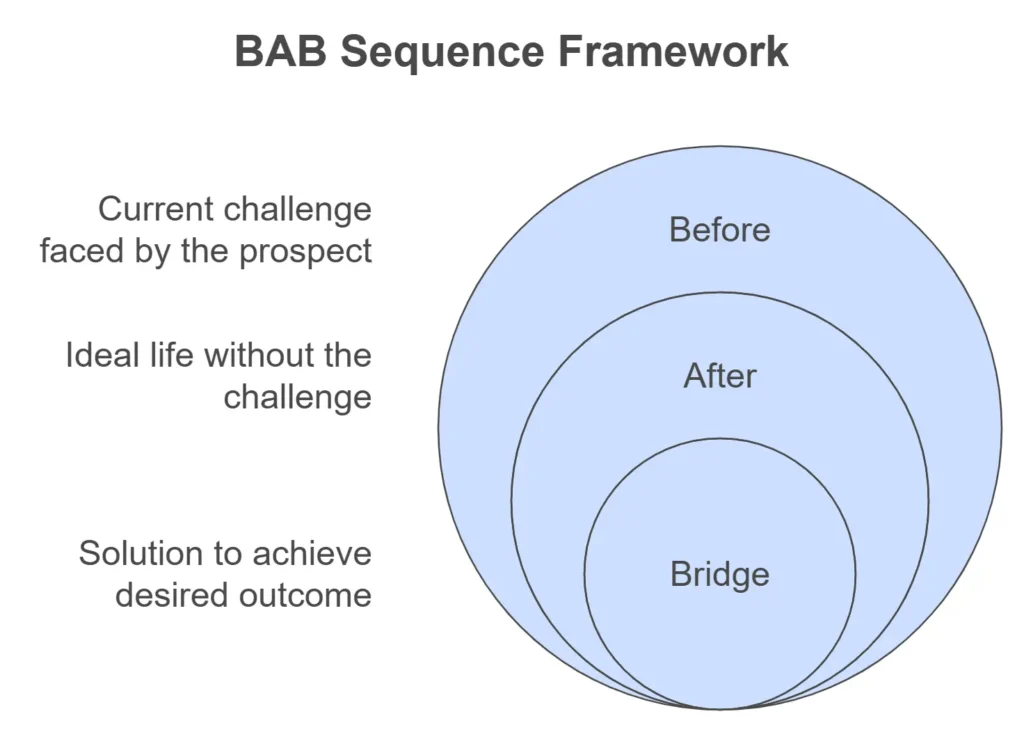
The BAB (Before-After-Bridge) sequence is a powerful storytelling framework that paints a picture of a prospect’s current challenge (“Before”), shows them what life could look like without it (“After”), and then provides your solution as the way to get there (“Bridge”). This model works well because it leads with empathy and offers a clear path to a better outcome.
Best for: Education and online learning, Financial services
Step 1: Before scenario email
This email highlights a common challenge your prospect faces, helping them recognize the problem without immediately jumping into a pitch. The aim is to make the reader think, “Yep, that’s exactly what we’re dealing with.”
Step 2: After scenario email
Here, paint a picture of the ideal scenario where the problem no longer exists. This email should be aspirational, showing what life could look like if they had the solution.
Step 3: Bridging the gap email
Now, introduce your solution as the “bridge” that takes them from the “Before” scenario to the ideal “After” outcome. This email provides a straightforward invitation to connect and learn more.
This BAB sequence flows in a natural, relatable way leading the reader from identifying with their challenge to seeing the transformation and ultimately bridging the gap with your solution.
The 4Ps sequence (Promise, Picture, Prove, Push)
The 4Ps sequence—Promise, Picture, Prove, and Push—is designed to make a compelling case for your product or service by setting a clear expectation (Promise), painting a vivid outcome (Picture), backing it up with credibility (Prove), and finally prompting action (Push). This structure guides the reader through a logical flow that builds trust and drives engagement.
Best for: B2B SaaS (Software as a Service), Digital marketing agencies
Step 1: Promise email
Start by making a bold but credible promise that highlights a key benefit of your offering. This promise should resonate with a specific challenge or goal your prospect is likely focused on.
Think of the biggest outcome or improvement your product or service can deliver, and make that the focus of your opening line or subject.
Step 2: Picture email
Once you’ve made a promise, help your reader visualize the positive changes they could experience. Describe what their day-to-day could look like with this solution in place, and make it relatable to their current challenges.
Step 3: Prove email
Now that you’ve created interest, it’s time to build trust. Use data, case studies, or testimonials to support your promise. Showing real-world examples of similar companies or users who achieved measurable success can reinforce that your solution works.
Step 4: Push email
This final email encourages the recipient to take action. It’s the “push” they need to make a decision, so keep the CTA simple and inviting.
This 4Ps sequence is clear and direct. It leads the prospect from interest to action, with each step reinforcing the benefits and credibility of your offer.
The 4Us sequence (Urgent, Unique, Useful, Ultra-Specific)
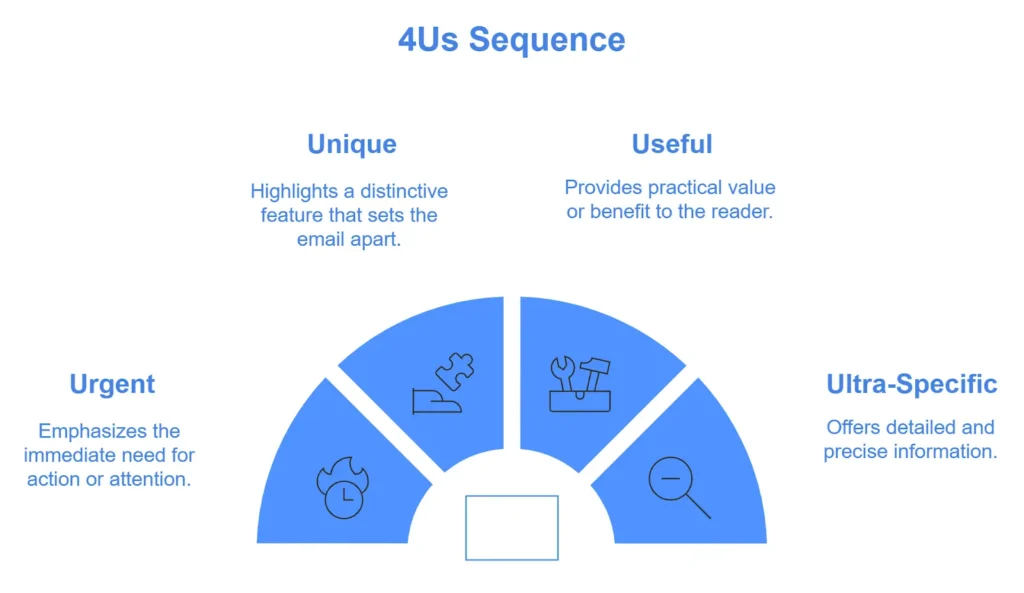
The 4Us sequence—Urgent, Unique, Useful, Ultra-Specific—is a framework for crafting emails that stand out and encourage immediate action. This approach makes emails more compelling by focusing on a timely benefit, a unique selling point, practical value, and specific details.
Best for: Real estate
Step 2: Unique email
This email should highlight what makes the approach or strategy different from the norm. Emphasize a unique advantage that separates it from typical solutions.
Step 3: Useful email
Focus on the practical value of your offering, describing how it solves a problem or meets a need in a useful way. This email should answer the “What’s in it for me?” question.
Step 4: Ultra-specific email
End with an email that dives into specific details, showing exactly how your solution works or the precise results it has achieved for others. This level of detail adds credibility and relevance.
In practice, the 4Us sequence is effective because it combines psychological triggers that appeal to both logical and emotional decision-making. It encourages the recipient to open, read, engage, and act.
For teams looking to improve response rates, the 4Us framework provides a reliable structure that prioritizes clarity, relevance, and action, making it especially suitable for targeted outreach.
Best email sequences by industry
Below we have listed the best email sequences by industry, so you can easily review and pick which fits you.
1. B2B SaaS (Software as a Service)
- Effective sequence: 4Ps Sequence (Promise, Picture, Prove, Push)
- Why: B2B SaaS buyers are typically looking for solutions that offer clear value and quantifiable outcomes. The 4Ps sequence appeals to this by promising specific benefits, demonstrating how the solution can transform their current state, providing social proof through case studies, and pushing for a trial or demo.
- Example: Promise increased productivity, show how the software simplifies workflows, share a case study from a similar company, and offer a quick demo.
2. E-commerce
- Effective sequence: AIDA (Attention, Interest, Desire, Action)
- Why: In e-commerce, buyers often make faster decisions than in B2B settings. AIDA effectively captures attention and moves potential customers quickly from interest to action.
- Example: Start with an eye-catching discount or benefit, build interest by highlighting product features, create desire with social proof or testimonials, and end with a strong, time-sensitive CTA like a limited-time offer.
3. Consulting and professional services
- Effective sequence: PAS (Problem, Agitation, Solution)
- Why: In consulting, buyers often need help identifying and addressing complex pain points. The PAS sequence is effective here as it draws attention to the problem, increases urgency by highlighting the costs of inaction, and presents the consultant’s services as a tailored solution.
- Example: Identify a common industry challenge, emphasize how it affects clients, and explain how your expertise directly addresses it with a brief case study.
4. Financial services
- Effective sequence: BAB (Before-After-Bridge)
- Why: Financial services buyers are drawn to stability and clear improvements in their financial outcomes. The BAB sequence allows providers to paint a picture of a client’s current state, show what financial freedom or stability could look like, and then “bridge the gap” with their services.
- Example: Outline common financial challenges, show the benefits of proactive financial management, and offer a call to action for a consultation.
5. Real estate
- Effective Sequence: 4Us (Urgent, Unique, Useful, Ultra-Specific)
- Why: Real estate is competitive and fast-paced, with potential buyers or investors often needing to act quickly. The 4Us sequence works well by creating urgency, highlighting unique property or investment opportunities, providing useful information, and delivering specific details about the market.
- Example: Emphasize time-sensitive opportunities, highlight unique property benefits, offer insights into market trends, and provide ultra-specific details about the investment potential.
6. Healthcare and wellness
- Effective sequence: AIDA or PAS
- Why: Healthcare buyers often seek solutions to pressing health challenges, making both the AIDA and PAS sequences effective. AIDA is ideal for wellness products, while PAS is suited for more complex healthcare solutions that address specific health problems.
- Example: For wellness products, use AIDA to capture interest and prompt action (e.g., buying a supplement). For more involved services, use PAS to address a health issue, emphasize the risk of leaving it untreated, and offer a solution.
7. Education and online learning
- Effective Sequence: BAB or AIDA
- Why: Education buyers are focused on learning outcomes and skill development. The BAB sequence helps potential students envision the transformation your course or program can bring. AIDA is effective for shorter courses or offers that require a quicker decision.
- Example: Show a typical “before” scenario (e.g., lacking certain skills), describe the potential outcome after the course, and bridge the gap with a call-to-action to enroll.
8. Non-profit and social causes
- Effective sequence: PAS (Problem, Agitation, Solution)
- Why: Non-profits and social organizations often need to convey an urgent problem to generate empathy and support. PAS is ideal for stirring action by highlighting the problem, emphasizing its impact, and showing how donors or volunteers can help solve it.
- Example: Outline a community issue, describe the consequences if it’s not addressed, and present a donation or volunteer opportunity as the solution.
9. Digital marketing agencies
- Effective sequence: 4Ps or AIDA
- Why: Marketing clients want results quickly but need to feel confident in the agency’s capabilities. The 4Ps sequence helps establish credibility and trust through proof and a clear value proposition, while AIDA is helpful for quicker pitches around specific campaigns or promotions.
- Example: Promise improved metrics, paint a picture of campaign success, prove with past client results, and push for a call or proposal review.
When to stop sending emails
Knowing when to stop is key to avoiding overspam and keeping your email reputation intact. Here are a few guidelines:
- Set a clear limit: Typically, 3-4 emails per sequence are sufficient. If there’s no response after that, it’s best to step back.
- Respectful breakup email: Make the final email polite and open-ended, giving the recipient a chance to reach out later if they’re interested.
- Watch for engagement: If open or click rates are consistently low, it’s a signal to pause. Sending too many emails to unresponsive recipients can damage your sender reputation.
- Offer an opt-out: Always provide an easy way for recipients to unsubscribe or indicate they’re not interested.
Key metrics to measure in email sequences
Tracking key metrics in your email sequences is a must for understanding the effectiveness of your outreach and refining your approach.
1. Open rates
Why it’s important: Open rates are the first indicator of your email’s ability to capture attention. They show how well your subject lines resonate with recipients and, indirectly, how targeted your audience is. However, open rates can be affected by factors like the email provider or image-blocking settings, so it’s important to interpret them carefully.
What to aim for: A typical open rate for cold emails ranges from 15% to 25%, depending on the industry and audience. Anything lower could indicate that your subject lines aren’t compelling or that your emails may not be reaching the right people.
Improvement tips:
- Optimize subject lines: Make them short, personalized, and relevant.
- Timing: Experiment with sending times to see when your audience is most likely to open emails.
- Audience segmentation: Ensure you’re targeting the right people based on interests and relevance.
2. Response rates
Why it’s important: Response rates are a stronger indicator of engagement than open rates. They show that recipients are not only reading your email but are also interested enough to reply. Response rates reflect the relevance of your message and the effectiveness of your email copy in sparking a conversation.
What to aim for: Average response rates for cold emails can be between 1% and 10%. Higher rates suggest that your messaging is well-targeted, while lower rates may indicate the need for better personalization or a clearer value proposition.
Improvement tips:
- Personalization: Use specific details about the recipient or their company to make the email feel more relevant.
- Clear and simple CTAs: Make it easy for recipients to respond with a straightforward, single call-to-action.
- Value-driven content: Ensure each email offers a clear benefit or solution, focusing on how you can solve a problem for the recipient.
3. Conversion rates
Why it’s important: Conversion rates measure how many recipients took the desired action, such as booking a call, signing up for a demo, or visiting a landing page. This is a critical metric because it reflects the ultimate effectiveness of your cold email sequence in moving prospects closer to a goal.
What to aim for: Conversion rates will vary widely based on the industry, offer, and call-to-action. A typical conversion rate for cold emails might be in the range of 0.5% to 5%. Higher conversion rates are a sign that your email sequence is persuasive and successfully drives action.
Improvement tips:
- Strong value proposition: Clearly communicate the value of taking action. What’s in it for them?
- Simplify the CTA: Make sure your call-to-action is specific and easy to complete with minimal steps.
- Follow-up: Don’t rely on just one email to drive conversions; follow up strategically to reinforce the benefits and prompt action.
Conclusion
You can use human psychology to craft cold email sequences that feel relevant and spark genuine interest. Frameworks like 4Ps, AIDA, PAS, and 4Us work because they align with how people process information—catching attention, building trust, and encouraging action.
Getting the technical basics right, like warming up your email and setting up SPF/DKIM, ensures you land in the inbox, while tracking key metrics helps you stay tuned to what works. Each industry has its nuances, so tailor your message to fit, whether that means data-driven results for SaaS or time-sensitive offers for e-commerce.
And finally, know when to let it rest. Not every email needs a follow-up, and sometimes the best approach is a concise sequence that gives the prospect room to respond on their terms. A respectful, well-thought-out approach with the right cold email sequences will always go further than relentless follow-ups.

